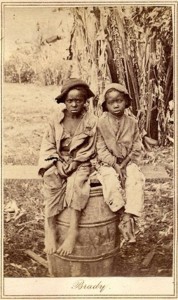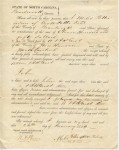EDIT: It turns out that the AP story, Keya Morgan and the other experts cited in this article were totally wrong. It’s not a Brady print; it’s not of slave children and it’s not even rare. Here’s a copy in the New York Public Library
where you can see the photographer was Jerome Nelson, the picture was taken ca. 1870 and is charmingly entitled “Plantation Scene; Happy Little Nigs.”
I actually think the truth is even more compelling that the falsehood. That’s what passed for “happy” for black kids in the post-Reconstruction South. Many thanks to Linda Rowan for alerting me to the bullshit in a comment below.
 A Civil War-era picture of two slave children was found in the attic of a Charlotte, North Carolina home. The homeowner was collecting things for a moving sale and found the picture along with a document describing the sale of one “John” in 1854.
A Civil War-era picture of two slave children was found in the attic of a Charlotte, North Carolina home. The homeowner was collecting things for a moving sale and found the picture along with a document describing the sale of one “John” in 1854.
In April, the photo was found at a moving sale in Charlotte, accompanied by a document detailing the sale of John for $1,150, not a small sum in 1854.
New York collector Keya Morgan said he paid $30,000 for the photo album including the photo of the young boys and several family pictures and $20,000 for the sale document. Morgan said the deceased owner of the home where the photo was found was thought to be a descendant of John.
A portrait of slave children is rare, Morgan said.
“I buy stuff all the time, but this shocked me,” he said.
Art historians think the picture was taken in the early 1860s, either right before or right after Abraham Lincoln issued the Emancipation Proclamation in 1862. The picture is from the Brady studio, however this photograph was most likely not taken by Matthew Brady himself, but by his apprentice Timothy O’Sullivan. Matthew Brady, the famous Civil War photographer, and his apprentices took many pictures of slaves around that time. They were used by abolitionists to drum up support for the war in the North.
Most of those pictures were of adult slaves who have been severely physically abused and had visible scars, though. Children, even incredibly sad-eyed ones like the boys in this picture, were not so obvious symbols of the violence and degradation of slavery.
Keya Morgan has a well-known collection of Civil War photographs, including the world’s largest collection of original Abraham Lincoln photographs. He’s keeping the picture and document in his personal collection right now, but he’s already received a sales inquiry from the Metropolitan Museum of Art. Other photographs in his collection have found permanent homes in the collections of the White House, the Library of Congress, and the Smithsonian and even the Louvre.
 Morgan is also considering collaborating on a documentary about John. From the article it’s clear that Morgan thinks the John described in the sales document is one of the boys in the picture, but I’m not sure how they know that. Perhaps there’s an age reference in the document that I can’t read (there are no high resolution pictures that I could find), or maybe it’s just an assumption or even symbolic shorthand.
Morgan is also considering collaborating on a documentary about John. From the article it’s clear that Morgan thinks the John described in the sales document is one of the boys in the picture, but I’m not sure how they know that. Perhaps there’s an age reference in the document that I can’t read (there are no high resolution pictures that I could find), or maybe it’s just an assumption or even symbolic shorthand.